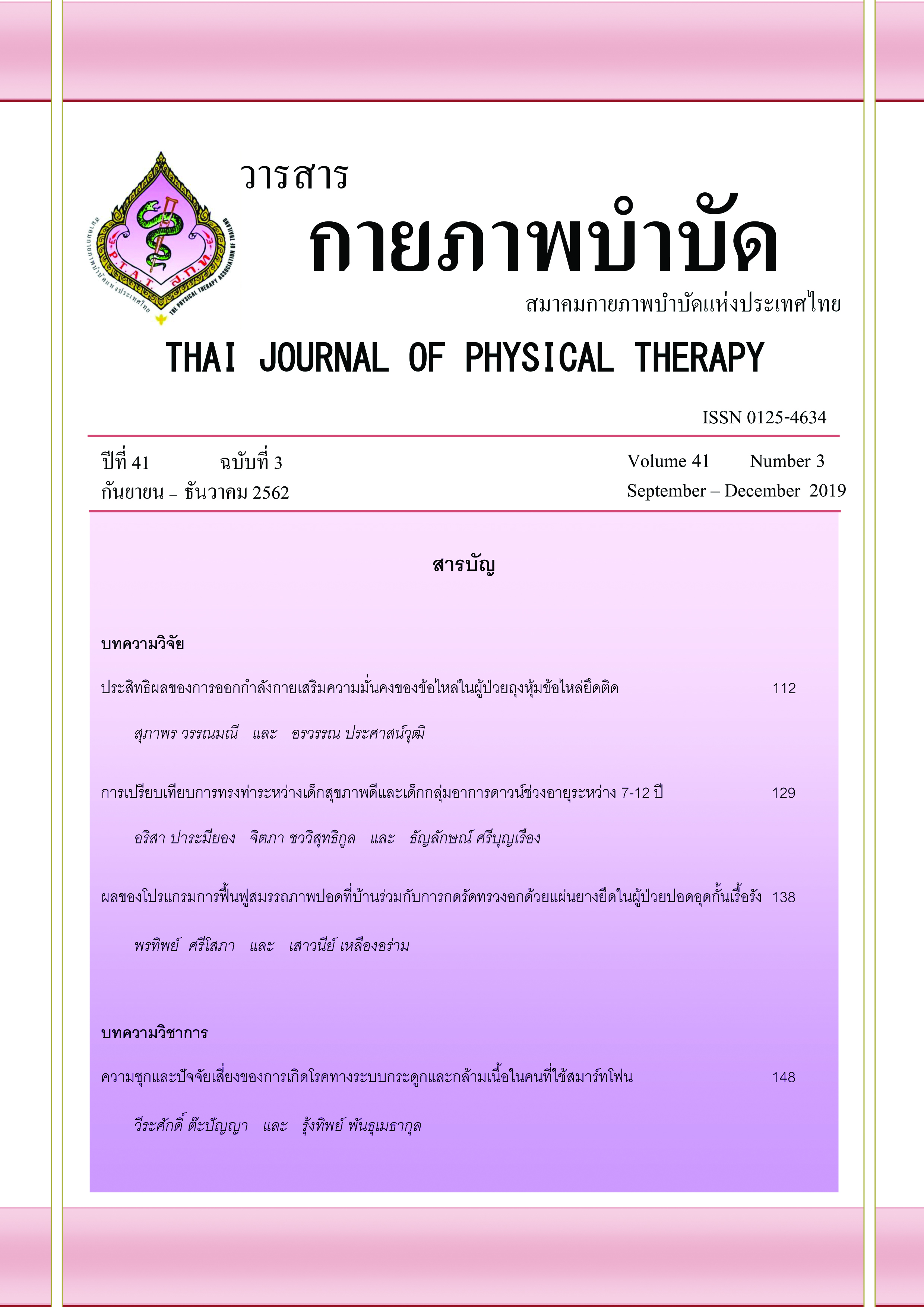ความชุกและปัจจัยเสี่ยงของการเกิดโรคทางระบบกระดูกและกล้ามเนื้อในคนที่ใช้สมาร์ทโฟน
Main Article Content
บทคัดย่อ
โรคทางระบบกระดูกและกล้ามเนื้อมักจะเกิดขึ้นได้บ่อยในกลุ่มคนที่ใช้สมาร์ทโฟนเป็นประจำ ซึ่งในปัจจุบันอาการทางระบบกระดูกและกล้ามเนื้อดังกล่าวพบว่ามีความชุกเพิ่มขึ้นเรื่อยๆ เนื่องจากประชาชนสามารถเข้าถึงสมาร์ทโฟนได้ง่าย โดยเกือบทุกคนและทุกช่วงวัยตั้งแต่เด็กจนถึงผู้ใหญ่จะมีสมาร์ทโฟนเป็นของตัวเอง จากการทบทวนวรรณกรรมที่ผ่านมาพบว่า ความชุกของการเกิดอาการทางกระดูกและกล้ามเนื้ออย่างน้อย 1 บริเวณในคนที่ใช้สมาร์ทโฟน มีความชุกตั้งแต่ร้อยละ 47.7 จนถึงร้อยละ 84.0 และบริเวณที่พบได้บ่อยที่สุดคือ คอ หลังส่วนบน นิ้วหัวแม่มือ และไหล่ ตามลำดับ โดยบริเวณคอพบความชุกประมาณร้อยละ 17.3 ถึงร้อยละ 67.8 บริเวณหลังส่วนบนร้อยละ 62.2 บริเวณนิ้วหัวแม่มือร้อยละ 9.8 ถึงร้อยละ 56.9 และบริเวณไหล่ร้อยละ 1.2 ถึงร้อยละ 54.8 ซึ่งปัจจัยเสี่ยงของการใช้สมาร์ทโฟนที่ทำให้เกิดโรคทางระบบกระดูกและกล้ามเนื้อประกอบไปด้วยหลายๆ ปัจจัย ได้แก่ ท่าทางการใช้สมาร์ทโฟน ระยะเวลาของการใช้สมาร์ทโฟน ลักษณะของการใช้งานสมาร์ทโฟน ไม่ว่าจะเป็นใช้ในการโทร การพิมพ์ข้อความ การสืบค้นข้อมูลทางอินเตอร์เน็ต การเล่นเกมส์ การจัดตารางเวลางาน หรือการใช้เพื่อความบันเทิง ฯลฯ เทคนิคการใช้งานสมาร์ทโฟน และปัจจัยอื่นๆ เช่น ขนาดของสมาร์ทโฟน เป็นต้น อย่างไรก็ตาม ปัจจัยต่างๆ ดังกล่าวก็ส่งผลต่อความเสี่ยงในการเกิดโรคทางระบบกระดูกและกล้ามเนื้อที่แตกต่างกันออกไป ดังนั้น วัตถุประสงค์ของบทความวิชาการฉบับนี้ เพื่อให้ทราบถึงปัจจัยที่ส่งผลทำให้เกิดโรคทางระบบกระดูกและกล้ามเนื้อในคนที่ใช้สมาร์ทโฟน และเพื่อกระตุ้นให้เกิดการหลีกเลี่ยงปัจจัยเสี่ยงดังกล่าว ซึ่งอาจจะสามารถช่วยลดอุบัติการเกิดโรคทางระบบกระดูกและกล้ามเนื้อในบริเวณต่างๆ จากการใช้สมาร์ทโฟนในอนาคตได้
Article Details
เอกสารอ้างอิง
2. Chu MK, Song HG, Kim C, Lee BC. Clinical features of headache associated with mobile phone use: a cross-sectional study in university students. BMC neurology. 2011; 11: 115.
3. Namwongsa S, Puntumetakul R, Swangnetr M. Prevalence of Musculoskeletal Disorders of Smartphone Users in Khon Kaen University Students, Thailand. The 2th National Ergonomics Conference, Thailand; 20-22 December 2017; Twin tower, Bangkok 2017. p. 54-63.
4. Namwongsa S, Puntumetakul R, Neubert MS, Boucaut R. Factors Associated with Neck Disorders among University Student Smartphone Users. Work. 2018; 61: 367-78.
5. Rammayan T, Boonyarit P, Pinsanoh I, Khruakhorn S, Kanchanoma S. Prevalence of Musculoskeletal Symptoms at Upper Body Parts Due to Smartphone using among Lower Secondary School Students. Srinagarind Med J 2016; 31: 392-8.
6. Shan Z, Deng G, Li J, Li Y, Zhang Y, Zhao Q. Correlational analysis of neck/shoulder pain and low back pain with the use of digital products, physical activity and psychological status among adolescents in Shanghai. PloS one. 2013; 8: e78109.
7. Stalin P, Abraham SB, Kanimozhy K, Prasad RV, Singh Z, Purty AJ. Mobile Phone Usage and its Health Effects Among Adults in a Semi-Urban Area of Southern India. J Clin Diagn Res. 2016; 10: LC14-6.
8. Kim HJ, Kim JS. The relationship between smartphone use and subjective musculoskeletal symptoms and university students. J Phys Ther Sci. 2015; 27: 575-9.
9. Balakrishnan R, Chinnavan E, Feii T. An extensive usage of hand held devices will lead to musculoskeletal disorder of upper extremity among student in AMU: a survey method. Int J Phys Educ Sports Health. 2016; 3: 368-72.
10. Eapen C, Kumar B, Bhat AK. Prevalence of cumulative trauma disorders in cell phone users. J Musculoskelet Res. 2010; 13: 137-45.
11. Xie Y, Szeto G, Dai J. Prevalence and risk factors associated with musculoskeletal complaints among users of mobile handheld devices: A systematic review. Appl Ergon. 2017; 59: 132-42.
12. Gustafsson E, Johnson PW, Lindegard A, Hagberg M. Technique, muscle activity and kinematic differences in young adults texting on mobile phones. Ergonomics. 2011; 54: 477-87.
13. Kim MS. Influence of neck pain on cervical movement in the sagittal plane during smartphone use. J Phys Ther Sci. 2015; 27: 15-7.
14. Choi JH, Jung MH, Yoo KT. An analysis of the activity and muscle fatigue of the muscles around the neck under the three most frequent postures while using a smartphone. J Phys Ther Sci. 2016; 28: 1660-4.
15. Lee S, Choi YH, Kim J. Effects of the cervical flexion angle during smartphone use on muscle fatigue and pain in the cervical erector spinae and upper trapezius in normal adults in their 20s. J Phys Ther Sci. 2017; 29: 921-3.
16. Lee SY, Lee DH, Han SK. The Effects of Posture on Neck Flexion Angle While Using a Smartphone according to Duration. Korean Soc Phys Med. 2016;11:35-9.
17. Namwongsa S, Puntumetakul R, Swangnetr Neubert M, Boucaut R. Effect of Neck Flexion Angles on Neck Muscle Activity among Smartphone Users With and Without Neck Pain. Ergonomics. 2019: 1-26.
18. Hegazy AA, Alkhail BA, Awadalla NJ, Qadi M, AI-Ahmadi J. Mobile phone use and risk of adverse health impacts among medical students in Jeddah, Saudi Arabia. Br J Med Med Res. 2016; 15: 1-11.
19. Lui DPY, Szeto GPY, Jones AYM. The pattern of electronic game use and related bodily discomfort in Hong Kong primary school children. Comput Educ. 2011; 57: 1665-74.
20. Goldfinch S, Gauld R, Baldwin N. Information and communications technology use, e-government, pain and stress amongst public servants. New Tech Work Employ. 2011; 26: 39-53.
21. Hakala PT, Rimpela AH, Saarni LA, Salminen JJ. Frequent computer-related activities increase the risk of neck-shoulder and low back pain in adolescents. Eur J Public Health. 2006; 16: 536-41.
22. Kim S-Y, Koo S-J. Effect of duration of smartphone use on muscle fatigue and pain caused by forward head posture in adults. J Phys Ther Sci. 2016; 28: 1669-72.
23. Park JHM, Kang SYP, Lee SGP, Jeon HSP. The effects of smart phone gaming duration on muscle activation and spinal posture: Pilot study. Physiother Theory Pract. 2017; 33: 661-9.
24. Ali M, Asim M, Danish SH, Ahmad F, Iqbal A, Hasan SD. Frequency of De Quervain's tenosynovitis and its association with SMS texting. Muscles Ligaments Tendons J. 2014; 4: 74-8.
25. Gustafsson E, Johnson PW, Hagberg M. Thumb postures and physical loads during mobile phone use - a comparison of young adults with and without musculoskeletal symptoms. J Electromyogr Kinesiol. 2010; 20: 127-35.
26. Ming Z, Pietikainen S, Hanninen O. Excessive texting in pathophysiology of first carpometacarpal joint arthritis. Pathophysiology. 2006; 13: 269-70.
27. Rom O, Kaisari S, Aizenbud D, Reznick AZ. Identification of possible cigarette smoke constituents responsible for muscle catabolism. J Muscle Res Cell Motil. 2012; 33: 199-208.


